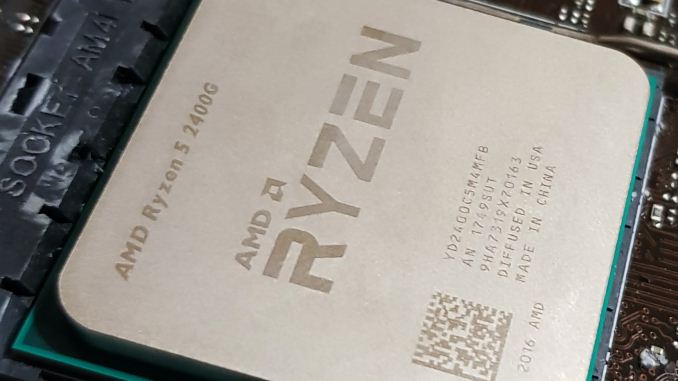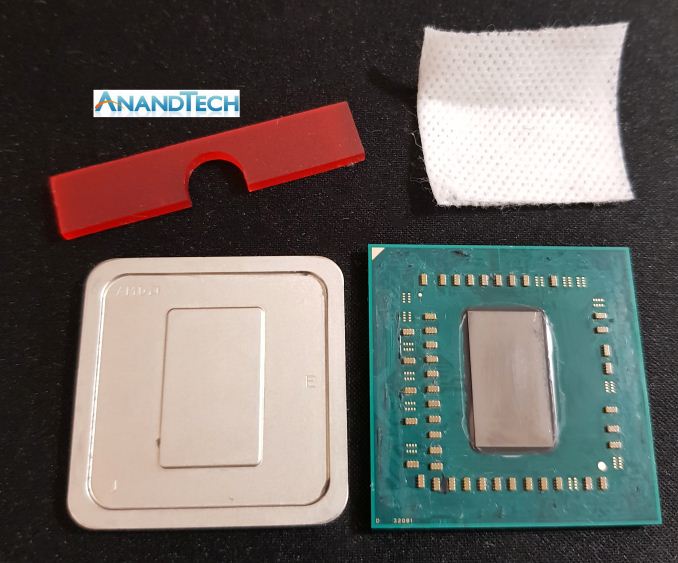AMD Ryzen 5 2400G and Ryzen 3 2200G Core Frequency Scaling: An Analysis
by Gavin Bonshor on June 20, 2018 10:05 AM EST- Posted in
- CPUs
- AMD
- Zen
- APU
- Vega
- Ryzen
- Ryzen 5
- Ryzen 3
- Scaling
- CPU Frequency
- Ryzen 3 2200G
- Ryzen 5 2400G

When AMD launched their first generation Ryzen-based APUs with a Zen cores and Vega graphics, both of the new parts entered the market at two very different budget-focused price points. The Ryzen 3 2200G, sitting at $99 for a quad-core CPU with Vega graphics was an amazing feat, and Ryzen 5 2400G coming in at $169 became the new integrated graphics champion. In our run of performance analysis articles, the question being asked today are relatively simple ones: 'how well do the new AMD Ryzen 2000 series APUs scale with core frequency'? We tested our APUs for standard benchmark performance, discrete gaming performance, and integrated graphics performance.
Core Frequency Scaling on The Ryzen 2000 Series
The perception when overclocking a CPU, or any other component for that matter, is that the increase in clock speed will directly correlate into better performance. The theory is pretty simple on paper, but the translation between the increase of clock rate and increase in performance can be a somewhat different story depending on the rest of the system or how the program is computed.
As a result, a 25% increase in clock speed only really correlates to a 25% jump in performance for the most simple programs, as there are many other limiting factors to consider such as bottlenecks on graphics, memory performance, or stalls in the compute pipeline.
In our testing for this article, we aim to go through and evaluate the differences and performance scaling at different frequencies on our APUs.
| AMD Ryzen 2000-Series APUs | ||
| Ryzen 5 2400G with Vega 11 |
Ryzen 3 2200G with Vega 8 |
|
| CPU Cores/Threads | 4 / 8 | 4 / 4 |
| Base CPU Frequency | 3.6 GHz | 3.5 GHz |
| Turbo CPU Frequency | 3.9 GHz | 3.7 GHz |
| TDP @ Base Frequency | 65 W | 65 W |
| Configurable TDP | 46-65 W | 46-65 W |
| L2 Cache | 512 KB/core | 512 KB/core |
| L3 Cache | 4 MB | 4 MB |
| Graphics | Vega 11 | Vega 8 |
| Compute Units | 11 CUs | 8 CUs |
| Streaming Processors | 704 SPs | 512 SPs |
| Base GPU Frequency | 1250 MHz | 1100 MHz |
| DRAM Support | DDR4-2933 Dual Channel |
DDR4-2933 Dual Channel |
| OPN PIB | YD2400C4FBBOX | YD2200C5FBBOX |
| OPN Tray | YD2400C5M4MFB | YD2200C4M4MFB |
| Price | $169 | $99 |
| Bundled Cooler | AMD Wraith Stealth | AMD Wraith Stealth |
Our previous articles covering the APU performance include a pure overclock analysis, as well as a detailed guide in delidding the processor for extra performance. We have a future article planned on memory performance.

After delidding the processor, for better thermal performance
For the testing, we took each of our APUs from 3.5 GHz to 4.0 GHz on the core frequency in 100 MHz jumps and performed our testing suite throughout. This correlates to a 14.3% performance jump overall, and matches the frequencies we saw in our overclocking articles. At each point we will compare to see if the performance uplift is even loosely correlated to CPU speed.
Test Bed Setup
As per our testing policy, we take a premium category motherboard suitable for the socket, and equip the system with a suitable amount of memory. With this test setup, we are using the BIOS to set the CPU core frequency using the provided straps on the MSI B350I Pro AC motherboard. The memory is set to the maximum supported frequency of DDR4-2933 with CAS latency timings of 18-18-18 within the BIOS to provide consistency throughout the different frequencies tested.
| Test Setup | |||
| Processors | AMD Ryzen 3 2200G | AMD Ryzen 5 2400G | |
| Motherboard | MSI B350I Pro AC | ||
| Cooling | Thermaltake Floe Riing RGB 360 | ||
| Power Supply | Thermaltake Toughpower Grand 1200 W Gold PSU | ||
| Memory | G.Skill Ripjaws V DDR4-3600 17-18-18 2x8 GB 1.35 V |
||
| Integrated GPU | Vega 8 1100 MHz |
Vega 11 1250 MHz |
|
| Discrete GPU | ASUS GTX 1060 Strix 1620 MHz Base, 1847 MHz Boost |
||
| Hard Drive | Crucial MX300 1 TB | ||
| Case | Open Test Bed | ||
| Operating System | Windows 10 Pro | ||
We must thank the following companies for kindly providing hardware for our multiple test beds.
Thank you to Crucial for providing us with MX300 SSDs. Crucial stepped up to the plate as our benchmark list grows larger with newer benchmarks and titles, and the 1TB MX300 units are strong performers. Based on Marvell's 88SS1074 controller and using Micron's 384Gbit 32-layer 3D TLC NAND, these are 7mm high, 2.5-inch drives rated for 92K random read IOPS and 530/510 MB/s sequential read and write speeds.
The 1TB models we are using here support TCG Opal 2.0 and IEEE-1667 (eDrive) encryption and have a 360TB rated endurance with a three-year warranty.
Further Reading: AnandTech's Crucial MX300 (750 GB) Review











29 Comments
View All Comments